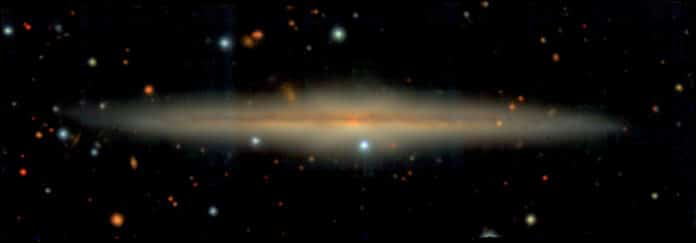The galaxy called UGC 10738, a galaxy broadly similar to the Milky Way, has distinct ‘thick’ and ‘thin’ discs identical to those of the Milky Way. Located about 320 million light-years away, the galaxy’s disk contains mainly ancient stars. It is identified because of its low ratio of iron to hydrogen and helium.
A new study that is the first detailed cross-section of a galaxy reveals that our galaxy evolved gradually instead of being the result of a violent mash-up. This suggests, contrary to previous theories that such structures are not the result of a rare long-ago collision with a smaller galaxy.
The study is a game-changer; it suggests that our milky way isn’t the product of a freak accident; instead, it is typical.
Nicholas Scott and Jesse van de Sande, from Australia’s ARC Centre of Excellence for All-Sky Astrophysics in 3 Dimensions (ASTRO 3D) said, “Our observations indicate that the Milky Way’s thin and thick discs didn’t come about because of a gigantic mash-up, but a sort-of ‘default’ path of galaxy formation and evolution. From these results, we think galaxies with the Milky Way‘s particular structures and properties could be described as the ‘normal ones.”
“It was thought that the Milky Way’s thin and thick discs formed after a rare violent merger and so probably wouldn’t be found in other spiral galaxies. Our research shows that’s probably wrong, and it evolved ‘naturally’ without catastrophic interventions. This means Milky Way-type galaxies are probably very common.”
“It also means we can use existing very detailed observations of the Milky Way as tools to analyze better, much more distant galaxies which, for obvious reasons, we can’t see as well.”
As the galaxy is angled ‘edge on,’ a look at it offered a cross-section of its structure effectively.
Jesse van de Sande, from Australia’s ARC Centre of Excellence for All-Sky Astrophysics in 3 Dimensions (ASTRO 3D), said, “Using an instrument called the multi-unit spectroscopic explorer or MUSE, we were able to assess the metal ratios of the stars in its thick and thin discs.”
“They were pretty much the same as those in the Milky Way—ancient stars in the thick disc, younger stars in the thin one. We’re looking at some other galaxies to make sure, but that’s pretty strong evidence that the two galaxies evolved in the same way.”
Dr. Scott said, “UGC 10738’s edge-on orientation meant it was simple to see which type of stars were in each disc.”
“It’s a bit like telling apart short people from tall people,” he said. “If you try to do it from overhead, it’s impossible, but if you look from the side, it’s relatively easy.”
Co-author Professor Ken Freeman from the Australian National University said, “This is an important step forward in understanding how disk galaxies assembled long ago. We know a lot about how the Milky Way formed, but there was always the worry that the Milky Way is not a typical spiral galaxy. Now we can see that the Milky Way’s formation is fairly typical of how other disk galaxies were assembled.”
ASTRO 3D director, Professor Lisa Kewley, added: “This work shows how the Milky Way fits into the much bigger puzzle of how spiral galaxies formed across 13 billion years of cosmic time.”
Journal Reference:
- Nicholas Scott et al. The American Astronomical Society, find out more. DOI: 10.3847/2041-8213/abfc57
